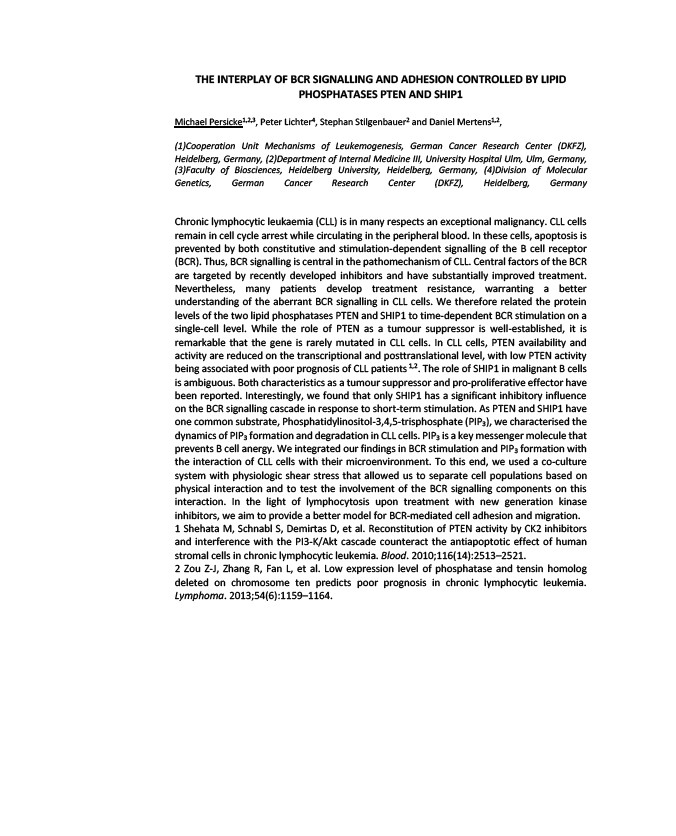
THE INTERPLAY OF BCR SIGNALLING AND ADHESION CONTROLLED BY LIPID
PHOSPHATASES PTEN AND SHIP1
Michael Persicke1,2,3, Peter Lichter4, Stephan Stilgenbauer2 and Daniel Mertens1,2,
(1)Cooperation Unit Mechanisms of Leukemogenesis, German Cancer Research Center (DKFZ),
Heidelberg, Germany, (2)Department of Internal Medicine III, University Hospital Ulm, Ulm, Germany,
(3)Faculty of Biosciences, Heidelberg University, Heidelberg, Germany, (4)Division of Molecular
Genetics, German Cancer Research Center (DKFZ), Heidelberg, Germany
Chronic lymphocytic leukaemia (CLL) is in many respects an exceptional malignancy. CLL cells
remain in cell cycle arrest while circulating in the peripheral blood. In these cells, apoptosis is
prevented by both constitutive and stimulation-dependent signalling of the B cell receptor
(BCR). Thus, BCR signalling is central in the pathomechanism of CLL. Central factors of the BCR
are targeted by recently developed inhibitors and have substantially improved treatment.
Nevertheless, many patients develop treatment resistance, warranting a better
understanding of the aberrant BCR signalling in CLL cells. We therefore related the protein
levels of the two lipid phosphatases PTEN and SHIP1 to time-dependent BCR stimulation on a
single-cell level. While the role of PTEN as a tumour suppressor is well-established, it is
remarkable that the gene is rarely mutated in CLL cells. In CLL cells, PTEN availability and
activity are reduced on the transcriptional and posttranslational level, with low PTEN activity
being associated with poor prognosis of CLL patients 1,2. The role of SHIP1 in malignant B cells
is ambiguous. Both characteristics as a tumour suppressor and pro-proliferative effector have
been reported. Interestingly, we found that only SHIP1 has a significant inhibitory influence
on the BCR signalling cascade in response to short-term stimulation. As PTEN and SHIP1 have
one common substrate, Phosphatidylinositol-3,4,5-trisphosphate (PIP3), we characterised the
dynamics of PIP3 formation and degradation in CLL cells. PIP3 is a key messenger molecule that
prevents B cell anergy. We integrated our findings in BCR stimulation and PIP3 formation with
the interaction of CLL cells with their microenvironment. To this end, we used a co-culture
system with physiologic shear stress that allowed us to separate cell populations based on
physical interaction and to test the involvement of the BCR signalling components on this
interaction. In the light of lymphocytosis upon treatment with new generation kinase
inhibitors, we aim to provide a better model for BCR-mediated cell adhesion and migration.
1 Shehata M, Schnabl S, Demirtas D, et al. Reconstitution of PTEN activity by CK2 inhibitors
and interference with the PI3-K/Akt cascade counteract the antiapoptotic effect of human
stromal cells in chronic lymphocytic leukemia. Blood. 2010;116(14):2513–2521.
2 Zou Z-J, Zhang R, Fan L, et al. Low expression level of phosphatase and tensin homolog
deleted on chromosome ten predicts poor prognosis in chronic lymphocytic leukemia.
Lymphoma. 2013;54(6):1159–1164.